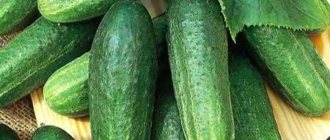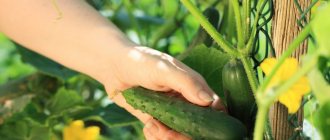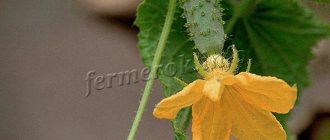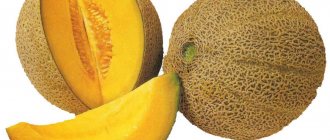Variety characteristics:
Properties of the Buratino variety:
Recommended region on the map:
Information on the admission of Cucumber Pinocchio from the Register of the State Variety Commission of the Russian Federation
Application for admission No. 43367, registered 2005-10-24. The Cucumber Buratino variety was included in the register of approved varieties in 2006. Approved for use in the regions: Northern, Northwestern, Central, Volga-Vyatka, Central Black Earth, North Caucasus, Middle Volga.
The originator of the variety Cucumber Buratino is:
- LLC BREEDING AND SEED PRODUCTION AGROFIRM `ILINICHNA` (141018, MOSCOW REGION, MYTISCHI-18, PO BOX 546)
Other plant varieties Cucumber
Search for variety by name
Variety selection
Question to the portal experts
If you haven't found the answer to a question, don't hesitate to ask an expert.
Register or Login so you don't have to enter your Name and Email every time
Thanks for the comment! It will be published after checking by a moderator!
No comments yet, be the first!
A portal for those who love their dacha
Your question has been sent for moderation. Don't worry, we quickly check your questions and your question will be answered within 1 day.
We have noticed that you are already registered on our website. We recommend that you log in to view the question you created. If you don't remember your password, you can recover it.
You were not registered until today, so we have registered you. Your password has been sent to your specified mailbox.
Help our site develop!
Please read this message, it will not take up much of your time!
We so need your comments and questions to understand in which direction we should develop.
Don't forget to leave a comment if you found what you were looking for. And if you haven’t found it, use the “Ask an Expert” form in the site header. We will answer this question, and other visitors will be able to find the information that you could not find.
Sincerely, team of the portal Dacha-Dacha.ru
'Pinocchio F1'
The early ripening cucumber 'Pinocchio F1', which takes 44-46 days from the emergence of shoots to the start of fruiting, is a parthenocarpic hybrid with a predominantly female type of flowering. Designed for cultivation under temporary film covers and in open ground. The hybrid is cold-resistant, high-yielding, with a bouquet arrangement of ovaries, of which there are up to 6 pieces in the nodes. The fruit is a large-tubercular, dark green, elongated cylindrical green plant, genetically devoid of bitterness, reaching 8-9 cm in length and weighing up to 100 g. About 11-13 kg of fruit are obtained from 1 m².
Top dressing
The Buratino cucumber hybrid requires a large amount of fertilizing in order for it to produce a rich harvest.
Therefore, you need to do everything as follows:
- In autumn, solid organic fertilizers are added to the soil. Over the winter, the concentration of ammonia will decrease and will be completely safe for the crop, and nutrients will remain in the soil.
- In the spring, a couple of days before planting, you need to disinfect the soil and add organic fertilizers again, but in liquid form. After this, the soil should be watered with clean water.
- Universal type mineral fertilizers are added 10 - 12 days after planting in open ground.
- Next, you need to repeat the addition of minerals in accordance with the instructions at intervals of 10 - 12 days.
Organic fertilizers must be added carefully if one wishes to use them during the season. They can burn the roots and the crop will die. Therefore, it must be added strictly at the root and in liquid form. At the same time, you should not allow an excess of minerals in the soil. Then the green mass will actively grow, but there will be no ovaries or there will be very few of them.
'Noble F1'
'Noble F1' is a bee-pollinated mid-early hybrid that begins to bear fruit 46-48 days after emergence. Designed for cultivation in film greenhouses and open ground. Plants of the variety are medium-sized, medium-branched, with a predominantly female type of flowering. The fruits are short, light green, white-thorned, finely tuberculated greens of a cylindrical shape, reaching 10-13 cm in length, weighing 100–110 g. The yield of the variety is about 12-14 kg per 1 m². The hybrid is resistant to a complex of diseases: bacteriosis, olive spot, viral infection , anthracnose and ascochyta blight.
Basket with cucumbers
List of the most productive varieties of cucumbers
The most productive varieties of cucumbers include: Dvoryansky, Buratino, Krepysh, White Night, Emelya, Vivat, Dasha, Dachnik, Pogrebok.
Noble
Refers to early ripening. For sowing, seeds are used that are sown in open soil; they can also be grown in a greenhouse. The pollination process is carried out with the help of bees. After the appearance of young plants, on days 45-49 they begin to delight with a fragrant harvest. It grows of medium height, with slight branching, and female-type flowering. Commercial cucumbers reach a small size (13 cm in length) and a weight of 110 g. The cucumber is light green in color with small tubercles and a cylindrical shape. 14 kg of aromatic crop grows per 1 m². This cucumber variety is one of the most highly resistant to diseases.
Pinocchio
Cucumbers of this variety ripen early. The yield parameters are among the highest. The variety is resistant to cold. Seeds can be grown both under film and in open soil. The culture pleases with cucumbers 45-46 days after the sprouts peck. The ovaries (up to 6 pcs.) are arranged in a bouquet-like manner. Commercial cucumbers have an oblong-cylindrical shape, dark green color, and large tubercles on the skin. They reach a length of 9 cm, weight – 100 g. 13 kg of juicy crop grows per 1 m² of bed. Cucumbers have a dense structure, no bitterness. The culture is resistant to many diseases.
Sturdy
Early ripening, excellent yield. Cucumbers appear 45 days after the appearance of small plants. For sowing, seeds are used that are planted in open soil; they can also be grown in a greenhouse. It has medium size, rich green foliage, medium climbing habit, and tufted ovary. Commercial cucumbers are small in size, 12 cm, each weighing on average 95 g. They have a cylindrical shape, a dark green rind, and pronounced tubercles. The transverse size of the cucumber is 3.5 cm. There are no notes of bitterness. 12 kg grows per 1 m².
White Night
Ripening is early and the yield is one of the highest. They can be grown both in open soil and using the greenhouse method. The bushes are of medium size, bright green leaves, medium climbing, tufted ovary. Pleases with fragrant cucumbers 43-45 days after the first sprouts appear. Vegetables are cylindrical in shape with lumpy skin of a dark green color and light light stripes. The cucumber grows up to 14 cm in length and weighs up to 125 g. The cross-section diameter is 4.3 cm. The pulp has a dense structure and no bitterness. On 1 m² of bed you can collect 12 kg of cucumbers. Most often consumed fresh, in salads. This garden crop has high resistance to diseases.
Emelya
It belongs to an early-ripening, high-yielding, self-pollinating, cold-resistant variety. It can be grown in a greenhouse, and the seeds can also be sown in open soil. This garden crop is medium in size, with tufted ovaries and small, slightly wrinkled leaves. Fragrant cucumbers appear 40-43 days after the germination of young sprouts. Cucumbers are dark green in color. The marketable fruits are elongated, cylindrical in shape, with large tubercles on the thin skin. It reaches 15 cm in size and 150 g in weight. The average cross-section diameter is 4.5 cm. Up to 16 kg of cucumbers grow per 1 m² of plot. This garden crop is resistant to many diseases. Taste characteristics and commercial qualities are good.
Vivat
Has high productivity. The height of the plant reaches 2.5 m. The leaves are medium sized. Climbing is average. The culture pleases with fruits on days 45-49 after germination. Cucumbers reach a length of 10 cm. The mass of a commercial cucumber is 80 g. It is characterized by a cylindrical shape. The crust is slightly ribbed with small tubercles. The cross-section diameter reaches 4 cm. The structure is dense, there are no notes of bitterness. For 1 m² of garden plot, up to 12 kg of fragrant harvest grows. Endowed with high commercial qualities.
Dasha
Refers to early ripening varieties. It has one of the highest yields. Designed for growing in greenhouses, seeds can also be sown in open ground. The plant reaches a height of up to 2.5 m. The bush has average climbing. It pleases with fruits on the 45th day after germination. Cucumbers reach 11 cm in length and weigh 130 g. They have a cylindrical shape, a skin with large tuberous formations. In cross-section, the diameter of the cucumber reaches 4 cm. The structure of the pulp is quite dense, with no voids. 19 kg of crop grows per 1 m² of garden area. Intended for fresh consumption, in salads.
Summer resident
This garden crop is early ripening and has a high degree of productivity. Pollinated by bees. It is grown in greenhouses; seeds are also sown in open soil. The crop begins to ripen 45 days after emergence. The bush is long, grows up to 2.5 m in height. Cucumbers reach a length of 11 cm and weigh 90 g. The yield per 1 m² is 10 kg. Cucumbers have a cylindrical shape and a coarsely lumpy skin surface. Features of the cross-section diameter of commercial cucumbers are 4 cm. The variety is characterized by high taste characteristics, there are no notes of bitterness. The structure of the pulp is dense, without void formations. Intended for fresh consumption.
Cellar
They are pleased with excellent yield and early ripening. It can be grown either in a greenhouse method or by sowing seeds in open soil. Cucumbers ripen 43-45 days after the appearance of young bushes. Branching is average, flowering is of mixed type. The leaves are small in size and rich green in color. Cucumbers reach a length of 10 cm, their weight is up to 120 g. 11 kg of aromatic crop grows per 1 m². The taste is excellent. Intended for use in salads, pickling, and canning. Endowed with resistance to complex diseases.
'Emelya F1'
One of the relatively few hybrids and varieties intended for cultivation indoors. The hybrid is parthenocarpic, early ripening - begins to bear fruit 40-42 days after emergence. Plants of the variety are medium-branched and vigorous, with a predominantly female type of flowering. Green, with short stripes of light color, the fruit is spindle-shaped, reaches 15 cm in length, and its weight can reach 120-150 g. The hybrid is resistant to diseases such as cucumber mosaic and olive spot. Tolerant to powdery mildew and root rot. From 1 m² you can collect 12-16 kg of fruit.
Almost all the varieties of cucumbers described in this article can be found in our catalog. Compare offers from different online stores to order seeds at the best price. View a selection of the most productive varieties and hybrids of cucumbers.
Pinocchio F1 is a promising variation of an old English variety (selected since 1897). The highlight of the hybrid is its long, smooth, completely seedless fruits. Among the advantages are excellent taste, oily, tender pulp with a characteristic crunch. There is also a variety of variety from “Elitagro” - cucumbers with coarsely tuberous skin and medium size.
The best varieties for greenhouses
This group includes those subspecies that are capable of self-pollinating, that is, they have both male and female flowers. These subspecies were developed specifically for the purpose of greenhouse cultivation, while most of them belong to universal species and have good protection against diseases. Here is a list of the most productive varieties that are usually grown in a greenhouse:
Alekseich F1
This variety is a hybrid, which significantly increases its natural resistance to diseases and parasites. For example, it is not afraid of powdery mildew and root rot, which can destroy the entire crop in the short term. It will take about 40 days for it to ripen, which will allow us to call the subspecies early ripening. The fruits grow small, their weight is about 70 grams. The taste qualities of cucumbers are high; summer residents and gardeners note the absence of bitterness and a sweet, fresh taste.
Benefit F1
This hybrid is also classified as early ripening; it will take about 35 days to ripen from the moment the first shoots appear on the ground. As for growth, Benefis F1 is classified as medium-sized; its fruits are small in size and have characteristic tubercles of a darker color. Benefit resists diseases well, including powdery mildew and cladosporiosis.
Meringue F1
This species is considered one of the earliest, it is also called super early; it will take only 30 days for the first cucumbers to appear in the garden. At the same time, the appearance of the fruit is characterized by a dark green color, has large tubercles, and the weight of one cucumber reaches about 90 grams. The hybrid can be grown equally successfully in the ground and in a greenhouse, since the plant tolerates movement and temperature changes well.
Murashka F1
This type of cucumber is also classified as an early one. Its flowering occurs in bunches, while the lateral shoots do not grow en masse; there are significantly fewer of them than on bushes of another variety. This makes it easier to care for the plant, including pinching, since you don’t have to remove many shoots.
The fruits have a large number of tubercles and thorns, but there is no bitterness in the taste. The weight of one cucumber reaches 100 grams. It is also worth noting good disease resistance.
In conclusion, let’s say that all of the above types of cucumbers are truly considered the best in their categories. However, before planting seeds of a particular variety, you should carefully read the instructions on the packaging, and also purchase seeds only at specialized sales points or from manufacturers, where you can get expert advice.
Description and characteristics of the variety
Pinocchio F1 is a unique long-fruited salad hybrid. It is widely used for slices, sandwiches, fresh assorted dishes, and regular snacks.
Cucumber is actively cultivated in open and protected beds, at home - in vegetable gardens on windowsills and loggias.
What are the signs:
- indeterminate growth type;
- parthenocarpic pollination;
- the bushes are tall, the side shoots are well developed;
- The ovaries are bouquet bunched, there are 3-4 ovaries in a node.
- length more than 20-22 cm;
- weight 130-150 g;
- diameter 3.5-4.5 cm;
- there are no tubercles or spines;
- the pulp is juicy and crisp;
- the skin is soft and glossy.
Cucumbers Buratino
Preparation
When working with seeds, it is necessary to carry out disinfection
containers (boxes, seedlings). Hands should be wearing gloves or should be washed periodically and wiped with napkins. There are very frequent cases when the infection gets on the seeds due to insufficiently carefully treated containers. New containers must be washed; it is advisable to soak already used containers for a day in a deochlor solution, 1 tablet per 5 liters of water, and then rinse thoroughly.
Soil for seedlings
It is better to prepare the soil yourself, so the cucumbers will grow better.
We offer three methods to choose from.
- For the first, mix humus and lowland black peat in equal proportions.
- Second option, use turf soil 30%, humus 30%, peat 30% and rotted sawdust 10%.
- For the third soil, take peat 30%, humus 50%, rotted sawdust 20%. To a bucket of any soil mixture you choose, you need to add one tablespoon of spring-summer fertika and two tablespoons of a soft dry deoxidizer and mix thoroughly.
Sowing time
Cucumber seeds begin to warm up at a temperature of 30-35 degrees a month before sowing. Cucumber seedlings do not grow for long, only 25-30 days.
Therefore, it is very important to calculate the date of sowing the seeds, focusing on the date of planting the cucumbers for permanent residence. These terms are different for everyone, depending on the growing zone. For example, if you plan to plant cucumber seedlings for permanent residence on May 1, then you need to sow the seeds to obtain high-quality seedlings on April 1.
Growing seedlings (without picking)
Sowing seeds in boxes is the worst option; even with the most careful picking, you will cause serious injury to the seedlings, partially cutting off their most important suction roots. That is why seedlings must be grown in individual seedling containers.
- Seedling cups are filled with soil mixture, moistened with a warm solution of diluted Ideal or Agricola liquid fertilizer for cucumbers, or other complex fertilizer. Then the prepared (warmed up for at least 30 days) seeds are laid directly on the surface of the soil and sprinkled with a 1-1.5 cm layer of the nutrient mixture. Do not water from above, but only sprinkle with warm water so that the seeds are not drawn deeper. Cover with film. Seedlings should not experience severe restrictions in the volume of soil for the roots. They need to be spaced wider as the seedlings grow to avoid stretching.
- Lighting is a very important point. In order to avoid sprouts stretching after germination, it is necessary to provide round-the-clock illumination for three days.
- After sowing, the seeds are kept at a temperature of plus 26-28 degrees. After germination, the temperature is lowered to plus 20-22 degrees, if the seedlings are stretched, then to plus 16. At temperatures below plus 16, cucumber seedlings are not grown.
- Before planting seedlings in the ground, it is necessary to carry out 2 feedings.
For the first, dilute one tablespoon of calcium nitrate per 10 liters of water. For the second, any complete complex fertilizer is suitable: water-soluble fertika lux, agricola, ideal health, etc. The third feeding is needed only if the seedlings are not growing well. For this we use diluted slurry in a ratio of 1 to 20 or ammonium sulfate solution. Once every 15 days, cucumber seedlings need to be sprayed with epin, 3-4 days after epin with zircon. This will help your cucumbers survive the stress of being transplanted to a permanent location.
Preparing the soil for planting
To prevent your cucumbers from being attacked by pests that carry diseases after planting, it is necessary to carry out preventive watering of the soil in seedling containers to prevent spider mites and other pests 3-4 days before moving them to their permanent place of residence. According to the instructions, dilute a systemic drug, for example: actara, or Apache, and spill the solution on the seedlings.
Transplanting
When planting cucumbers, you need to add food to each hole.
It is very good to add a teaspoon of Fertik spring-summer and a tablespoon of Borofoski (containing calcium, boron, potassium, magnesium) or Kalimag (or potassium sulfate), depending on what is available at the time of planting, the main thing is that the composition of the fertilizer satisfies the cucumber’s need for nutrition.
Feeding and fertilizers
The cucumber has an excellent appetite, so only a combination of root and foliar organomineral fertilizers can satisfy its nutritional needs.
For cucumbers, you need to have a significant supply: infusion of slurry or grass, infusion of ash (100 grams of ash per bucket), calcium nitrate, liquid vermicompost, potassium (humates), Magbor and complete complex fertilizers. It is necessary to feed cucumbers once every 10 days on a leaf with Calcium and once every 3-5 days with Potassium. Feeding with complex mixtures is required; they contain everything you need.
Growing and care
The hybrid variety does not require special care and is responsive to standard techniques:
- Watering. Multiplicity 3-4 times a week. Do not allow the beds to become waterlogged or sour.
- Feeding. Requires 4-5 fertilizer applications per season.
- Weeding, loosening, mulching.
- Author: Maria Sukhorukikh
Rate this article:
- 5
- 4
- 3
- 2
- 1
(0 votes, average: 0 out of 5)
Share with your friends!











